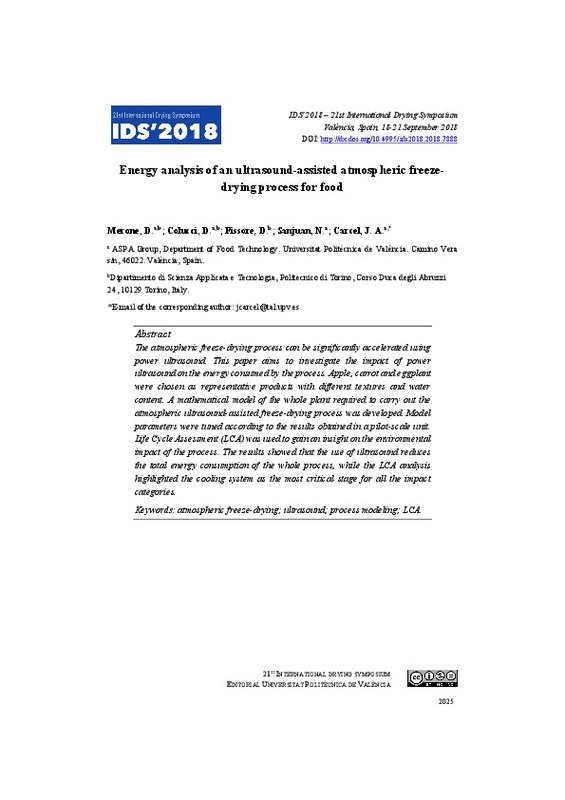JavaScript is disabled for your browser. Some features of this site may not work without it.
Buscar en RiuNet
Listar
Mi cuenta
Estadísticas
Ayuda RiuNet
Admin. UPV
Energy analysis of an ultrasound-assisted atmospheric freeze-drying process for food
Mostrar el registro sencillo del ítem
Ficheros en el ítem
| dc.contributor.author | Merone, Daniele
|
es_ES |
| dc.contributor.author | Colucci, Domenico
|
es_ES |
| dc.contributor.author | Fissore, Davide
|
es_ES |
| dc.contributor.author | Sanjuán, Neus
|
es_ES |
| dc.contributor.author | Cárcel, Juan
|
es_ES |
| dc.date.accessioned | 2019-02-25T08:00:23Z | |
| dc.date.available | 2019-02-25T08:00:23Z | |
| dc.date.issued | 2018-09-07 | |
| dc.identifier.isbn | 9788490486887 | |
| dc.identifier.uri | http://hdl.handle.net/10251/117258 | |
| dc.description.abstract | [EN] Power ultrasounds have been proposed and extensively investigated as an effective way to speed up the atmospheric freeze-drying process, thus making this dehydration process attractive from an industrial viewpoint. Nevertheless, a rigorous investigation on the impact of power ultrasounds on the energy consumed by the process is still missing. This paper aims to investigate this issue. Apple, carrot and eggplant were chosen as representative products with different textures and water content. A mathematical model of the whole plant required to carry out the atmospheric ultrasound-assisted drying process was developed to assess the effect of the operating conditions on the energy consumption. Model parameters were tuned on the basis of the results obtained in a pilot-scale unit, thus allowing the use of the model to simulate the whole industrial dehydration process. Life Cycle Assessment (LCA) was used as a complementary tool to gain an insight on the environmental impact of the process. Results showed that due to differences in the water diffusivity for the analyzed products, substantial differences in energy consumption can be highlighted. In fact, when the water diffusivity increases, the capacity of the material to move water away also increases and the time to obtain a dry product is thus reduced. Moreover, although the use of ultrasound causes an increase in the hourly energy consumption (kWh·h-1), the total energy consumption of the whole process (kWh) is lower, since the total operation time is reduced. The LCA results highlighted the cooling system as the most critical stage for all the impact categories studied. This is mainly due to the use of ethylene glycol and R-404 in the refrigeration cycle. Nevertheless, when dehydrating low porosity products the energy consumption of the air dryer increased and this stage becomes, the most critical from an environmental point of view | es_ES |
| dc.description.sponsorship | The authors acknowledge the financial support of INIA-ERDF throughout the project RTA2015-00060-C04-02 | es_ES |
| dc.format.extent | 8 | es_ES |
| dc.language | Inglés | es_ES |
| dc.publisher | Editorial Universitat Politècnica de València | es_ES |
| dc.relation.ispartof | IDS 2018. 21st International Drying Symposium Proceedings | es_ES |
| dc.rights | Reconocimiento - No comercial - Sin obra derivada (by-nc-nd) | es_ES |
| dc.subject | Drying | es_ES |
| dc.subject | Dehydration | es_ES |
| dc.subject | Dewatering | es_ES |
| dc.subject | Emerging technologies | es_ES |
| dc.subject | Products quality | es_ES |
| dc.subject | Process control | es_ES |
| dc.subject | Environmental | es_ES |
| dc.subject | Evaporation | es_ES |
| dc.subject | Sublimation | es_ES |
| dc.subject | Diffusion | es_ES |
| dc.subject | Energy | es_ES |
| dc.subject | Intensification | es_ES |
| dc.subject | Atmospheric freeze-drying | es_ES |
| dc.subject | Ultrasound | es_ES |
| dc.subject | Process modeling | es_ES |
| dc.subject | LCA | es_ES |
| dc.title | Energy analysis of an ultrasound-assisted atmospheric freeze-drying process for food | es_ES |
| dc.type | Capítulo de libro | es_ES |
| dc.type | Comunicación en congreso | es_ES |
| dc.identifier.doi | 10.4995/IDS2018.2018.7888 | |
| dc.relation.projectID | info:eu-repo/grantAgreement/MINECO//RTA2015-00060-C04-02/ | es_ES |
| dc.rights.accessRights | Abierto | es_ES |
| dc.description.bibliographicCitation | Merone, D.; Colucci, D.; Fissore, D.; Sanjuán, N.; Cárcel, J. (2018). Energy analysis of an ultrasound-assisted atmospheric freeze-drying process for food. En IDS 2018. 21st International Drying Symposium Proceedings. Editorial Universitat Politècnica de València. 20205-2032. https://doi.org/10.4995/IDS2018.2018.7888 | es_ES |
| dc.description.accrualMethod | OCS | es_ES |
| dc.relation.conferencename | 21st International Drying Symposium | es_ES |
| dc.relation.conferencedate | Septiembre 11-14, 2018 | es_ES |
| dc.relation.conferenceplace | Valencia, Spain | es_ES |
| dc.relation.publisherversion | http://ocs.editorial.upv.es/index.php/IDS/ids2018/paper/view/7888 | es_ES |
| dc.description.upvformatpinicio | 20205 | es_ES |
| dc.description.upvformatpfin | 2032 | es_ES |
| dc.type.version | info:eu-repo/semantics/publishedVersion | es_ES |
| dc.relation.pasarela | OCS\7888 | es_ES |
| dc.contributor.funder | Instituto Nacional de Investigación y Tecnología Agraria y Alimentaria | es_ES |
| dc.contributor.funder | Ministerio de Economía y Competitividad | es_ES |








